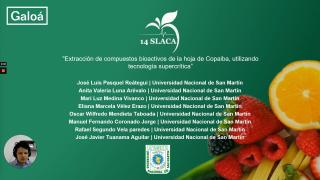Anais do Simpósio Latino Americano de Ciências de Alimentos
Anais do 14 SLACA - Simpósio Latino Americano de Ciência de Alimentos
EFFECT OF DIFFERENT TECHNIQUES ON THE EXTRACTION OF PHENOLIC COMPOUNDS FROM AGROINDUSTRIAL LIME (Citrus latifolia Tan.) RESIDUE
Como citar esse trabalho?
Para citar este trabalho use um dos padrões abaixo:
Como citar esse trabalho?
- Tipo de apresentação: Pôster
- Eixo temático: Engenharia de Processos e Tecnologias Emergentes (ET)
- Palavras chaves: Extraction; Emerging technology;; phenolic compounds;
Autoras(es):
- 1 Universidade Estadual de Campinas
- 2 Faculdade de Engenharia de Alimentos / Universidade Estadual de Campinas
EFFECT OF DIFFERENT TECHNIQUES ON THE EXTRACTION OF PHENOLIC COMPOUNDS FROM AGROINDUSTRIAL LIME (Citrus latifolia Tan.) RESIDUE
Amanda Mellissa B Oliveira
Universidade Estadual de Campinas
Agora você poderia compartilhar comigo suas dúvidas, observações e parabenizações
Crie um tópico- Tipo de apresentação: Pôster
- Eixo temático: Engenharia de Processos e Tecnologias Emergentes (ET)
- Palavras chaves: Extraction; Emerging technology;; phenolic compounds;
Autoras(es):
- 1 Universidade Estadual de Campinas
- 2 Faculdade de Engenharia de Alimentos / Universidade Estadual de Campinas
Lime (Citrus latifolia Tan.) is a citrus fruit marketed worldwide. Its processing generates a large amount of waste, of which approximately 50% is represented by bagasse (endocarp and mesocarp). The extraction of bioactive compounds from waste is a strategy to recover and add value to the agro-industrial by-products. Pressurized Liquid Extraction (PLE) and Ultrasound Assisted Extraction (UAE) are emerging techniques for obtaining bioactive compounds from plant matrices. Thus, the objective of this work was to compare different extraction techniques to obtain phenolic compounds from agro-industrial lime by-product. The extraction solvent was a mixture of ethanol and water (3:1, m/m), except for Soxhlet, which used pure ethanol. PLE was carried out at 10 MPa, 60, 85, and 110 °C, for 40 minutes. In UAE, powers of 160, 480, and 792 W were used, ranging time between 2 and 10 minutes at 20 kHz. Agitation extraction (300 rpm) used the same times as UAE and temperature of 72 °C. Soxhlet extraction was carried out for 6 hours. The total phenolic content (TPC) of the extracts was determined by the Folin-Ciocalteu method. The obtained TPCs were, in mg GAE/g sample: PLE (17.65 ± 0.03), UAE (9.95 ± 0.08), Agitation (3.65 ± 0.01), and Soxhlet (2.19 ± 0.05). The highest yield in PLE (110 °C) showed that temperature significantly influenced the extraction, whereas, in UAE, cavitation increased mass transfer and, therefore, the extraction of the target compounds. In general, the TPC of extracts obtained by emerging methods was higher than those obtained by conventional methods, demonstrating the great potential of these techniques to recover bioactive compounds from plant matrices.
Continuar na linha pesquisa
Rafael Fernandes Almeida
Sugiro se aprofundar mais nessa área de pesquisa, pois é um assunto muito interessante.
- 1 like
- 2 respostas
Discussões Científicas de Qualidade
Com ~200 mil publicações revisadas por pesquisadores do mundo todo, o Galoá impulsiona cientistas na descoberta de pesquisas de ponta por meio de nossa plataforma indexada.
Confira nossos produtos e como podemos ajudá-lo a dar mais alcance para sua pesquisa:
Como citar esse proceedings?
Esse proceedings é identificado por um DOI , para usar em citações ou referências bibliográficas. Atenção: este não é um DOI para o jornal e, como tal, não pode ser usado em Lattes para identificar um trabalho específico.
Verifique o link "Como citar" na página do trabalho, para ver como citar corretamente o artigo



Amanda Mellissa B Oliveira
Obrigada pela sugestão! No doutorado eu vou continuar trabalhando com aproveitamento de resíduos e extrações com altas pressões, porém, irei trabalhar com solventes verdes (eutéticos), muito mais seguros e sustentáveis que os solventes comumente empregados. Pretendo, também, testar mais condições experimentais e pensar numa forma de empregar os compostos extraídos.
Amanda Mellissa B Oliveira
Também penso em aproveitar os demais compostos da casca do limão para extrações posteriores.